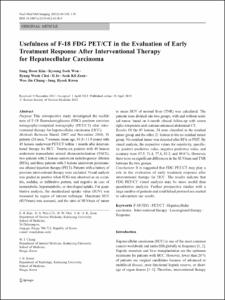KUMEL Repository
1. Journal Papers (연구논문)
1. School of Medicine (의과대학)
Dept. of Nuclear Medicine (핵의학)
Usefulness of F-18 FDG PET/CT in the Evaluation of Early Treatment Response After Interventional Therapy for Hepatocellular Carcinoma
- Alternative Author(s)
- Won, Kyoung Sook; Zeon, Seok Kil; Chung, Woo Jin; Kwon, Jung Hyeok
- Journal Title
- Nuclear Medicine and Molecular Imaging
- ISSN
- 1869-3474
- Issued Date
- 2012
- Keyword
- F-18 FDG; PET/CT; Hepatocellular carcinoma; Interventional therapy; Locoregional therapy; Response
- Abstract
- Purpose This retrospective study investigated the usefulness
of F-18 fluorodeoxyglucose (FDG) positron emission
tomography/computed tomography (PET/CT) after interventional
therapy for hepatocellular carcinoma (HCC).
Methods Between March 2007 and November 2010, 31
patients (24 men, 7 women; mean age, 61.8±11.0 years) with
45 lesions underwent PET/CT within 1 month after interventional
therapy for HCC. Twenty-six patients with 40 lesions
underwent transcatheter arterial chemoembolization (TACE),
two patients with 2 lesions underwent radiofrequency ablation
(RFA), and three patients with 3 lesions underwent percutaneous
ethanol injection therapy (PEIT). Patients with a history of
previous interventional therapy were excluded. Visual analysis
was graded as positive when FDG was observed as an eccentric,
nodular, or infiltrative pattern, and negative in case of
isometabolic, hypometabolic, or rim-shaped uptake. For quantitative
analysis, the standardized uptake value (SUV) was
measured by region of interest technique. Maximum SUV
(SUVmax) was assessed, and the ratio of SUVmax of tumor
to mean SUV of normal liver (TNR) was calculated. The
patients were divided into two groups, with and without residual
tumor, based on 6-month clinical follow-up with serum
alpha-fetoprotein and contrast-enhanced abdominal CT.
Results Of the 45 lesions, 24 were classified in the residual
tumor group and the other 21 lesions in the no residual tumor
group. No residual tumor was detected after RFA or PEIT. By
visual analysis, the respective values for sensitivity, specificity,
positive predictive value, negative predictive value, and
accuracy were 87.5, 71.4, 77.8, 83.3, and 80.0 %. However,
there were no significant differences in the SUVmax and TNR
between the two groups.
Conclusions It is suggested that FDG PET/CT may play a
role in the evaluation of early treatment response after
interventional therapy for HCC. The results indicate that
FDG PET/CT visual analysis may be more useful than
quantitative analysis. Further prospective studies with a
large number of patients and established protocol are needed
to substantiate our results.
Keywords F-18 FDG . PET/CT . Hepatocellular
carcinoma . Interventional therapy . Locoregional therapy .
Response
Introduction
- Publisher
- School of Medicine
- Citation
- Sung Hoon Kim et al. (2012). Usefulness of F-18 FDG PET/CT in the Evaluation of Early Treatment Response After Interventional Therapy for Hepatocellular Carcinoma. Nuclear Medicine and Molecular Imaging, 46(2), 102–110. doi: 10.1007/s13139-012-0138-8
- Type
- Article
- ISSN
- 1869-3474
- 파일 목록
-
-
Download
 oak-aaa-04004.pdf
기타 데이터 / 431.96 kB / Adobe PDF
oak-aaa-04004.pdf
기타 데이터 / 431.96 kB / Adobe PDF
-
Items in Repository are protected by copyright, with all rights reserved, unless otherwise indicated.